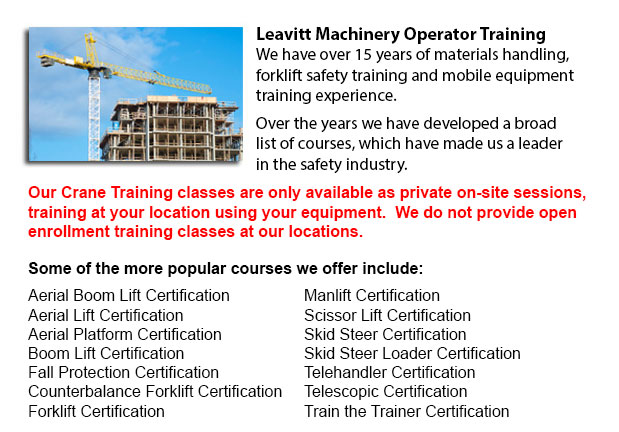
Crane Certification Hamilton - The Crane Certification training program includes content suggested by industry about the safe and efficient operation of cranes. People training would learn the following: pre-operational, operational and post operating requirements; how to identify cranes and their component parts; rigging components and inspection/rejection criteria; how to determine overall lift capacity; and requirements particular to the work site where the people training would be operating.
The requirements which should be done before operating a crane such as assigning authority for the pre-operational check; performing the sequential pre-operational check based on the manufacturer's specifications or specifications certified by a professional engineer; inspecting the work area for hazards and obstacles; checking the log book for comments; inspecting cables, hooks, chains crane movement and safety latches; making certain of the correct functioning of operational controls; and knowing how to make certain that the crane's disconnect switch/isolator is properly working.
Operational requirements include identifying responsibilities and roles, and determining the need for a formal lift plan. Trainees would know how to carry out a hazard assessment associated to environmental conditions, physical situations and staff. Subject matter comprises determining when to seek competent assistance, the destination of loads and the safest route, and centre of gravity and load weight.
Individuals training should be able to identify an over-capacity lift, in addition to be able to pick correct rigging machinery, select load restrictions, and to determine the safe location for the crane to operate from. Trainees will review both universal and site-specific crane signals for lifts, and techniques for loading, traveling and lifting. Proper maintenance habits will also be included.
Individuals training will be evaluated on their knowledge of the need for emergency response procedures for various circumstances such as a mechanical or electrical failure. They would be asked to describe shut down and parking procedures for security and safety, to follow lock out and tagging techniques, and to explain why near misses are recorded and reported to the right individual. Log book records need to be maintained.
Individuals training would develop knowledge of rigging, particularly, establishing who has authority and responsibility for rigging, identifying various kinds of rigging, knowing load capacity ratings and storage procedures.
Post-operational requirements consist of entering deficiencies or defects, service and maintenance history in the log book, based on state, provincial and federal codes requirements.
Site-specific needs could be included into the safety training program according to the employer's requirements.
-
Crane Training School Hamilton
Crane Training School Hamilton - We provide industry relevant programs in our crane training school. The course would provide our trainees with learning outcomes matching the current industry demands. Our small class sizes combine theory and hand-on... More -
Crane Ticket Hamilton
Crane Ticket Hamilton - The new kind of a crane can be either complex or simple, and cranes differ based on their application. Mobile cranes, for example are quite simple. A telescopic boom or steel truss mounts its movable platform. A system of pull... More -
Aerial Platform Training Hamilton
Aerial Platform Training Hamilton - Aerial forklifts can be utilized to accomplish many different duties executed in hard to reach aerial spaces. Many of the tasks associated with this type of lift include performing routine upkeep on buildings with... More -
Forklift Safety Training Hamilton
Forklift Safety Training Hamilton - People wanting work in businesses which utilize lift trucks have to undergo a forklift safety training course before becoming a certified operator of a forklift. There are several ways to go about acquiring forklif... More -
Aerial Lift Certification Hamilton
Aerial Lift Certification Hamilton - Aerial Lift Certification is for workers who require a thorough knowledge of aerial lift safety. Maintenance workers, construction craftsmen and supervisors require this training to ensure that operators and inspe... More -
Crane Safety Training Hamilton
Crane Safety Training Hamilton - Both crane operator and their employers need to know all the possible problems associated to the use of an overhead crane. All over North America, there is legislation which provides rules for the safe inspection, mai... More -
Telehandler License Hamilton
Telehandler License Hamilton - A telehandler or telescopic handler is an equipment that is frequently utilized in industrial and agricultural applications. It has the same appearance to a lift truck and even functions in a similar manner, even if, th... More -
Heavy Equipment License Hamilton
Heavy Equipment License Hamilton - Acquiring a heavy equipment license is mandatory to operate these large industrial machines. Certification could be obtained through a vocational school or private training. The license would allow the driver to ope... More

Forklift Training Hamilton
TOLL FREE: 1-888-254-6157
Hamilton, Ontario
forklifttraininghamilton.com
Email Us
About Us


